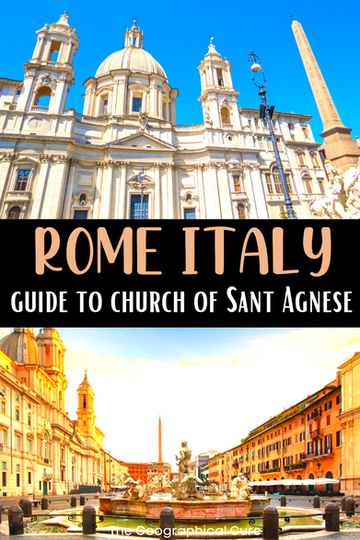Here’s my visitor’s guide to the Church of Sant’Agnese in Rome. The church is one of the most beautiful churches in Rome. It’s located smack in the middle of the historic Piazza Navona, the very symbol of Rome.
But the Baroque church doesn’t get the attention it deserves. People gawk at the Bernini fountains and forget to walk inside. That’s a mistake. The church is quite lovely, and a worthy hidden gem in Rome.
The Baroque church of Sant’Agnese in Agone was commissioned by Pope Innocent X, of the Doria Pamphilj family. It stands on the site of a much older church dedicated to St. Agnes. According to popular belief, she was martyred on this very spot.

History of the Church of Sant’Agnese
The Pamphilj family migrated to Rome from Gubbio at the end of the 15th century. Incredibly, given that they weren’t Roman patricians, the Pamphilj managed to have a family member elected as pope — Pope Innocent X in 1644.
Early in his reign, the family built a palazzo in the Piazza Navona next to the ancient Church of Sant’Agnese. Innocent X decided to rebuild the church as a chapel and mortuary for the palazzo.
Work on the church began in 1652 under the Roman architect Girolamo Rainaldi and his son Carlo. But the duo’s design was publicly criticized. The pair were soon replaced by the great Baroque architect Francesco Borromini. He gave Sant’Agnese his signature motif — a curving facade.
READ: Guide To the Dora Pamphilj Museum
In 1655, Pope Innocent X died. Borromini did not find favor, however, with the pope’s successor, Alexander VII of the Chigi family. Borromini resigned before he could be fired. The job was reassigned to Rainaldi.
When work slowed, Rainaldi was replaced by Gianlorenzo Bernini, the greatest Baroque sculpture. He duly finished the facade, altering it slightly, and the two bell towers to Borromini’s plans. Bernini also added marble and glitz to the interior, which might have horrified the more ascetic Borromini.
The church was completed in 1672. In 1673, the entrance stairway was added by Giuseppe Baratta.
The church remained in the private possession of the Pamphilj for over 300 years. But by the 19th century, it was in a serious state of disrepair. To their credit, the Pamphilj conducted an extensive restoration between 1852-59. The family finally donated the church to the Diocese of Rome in 1992. Another restoration took place in 2004.
The Architect Borromini
Borromini was an Italian architect who helped launch Roman Baroque architecture. The Baroque style was characterized by curves, domes, broken pediments and an inventive play on classical Renaissance detailing. At its height, Baroque structures were a sort of full-blooded architectural opera.
Borromini’s works combine classicism with passion. His buildings seem restlessly alive and sensational at the time. Manipulating classic forms, Borromini used concave and convex forms to animate his buildings and eschewed over-decoration.
Borromini was eccentric man, who lived life Baroquely. Some thought he was psychotic in his last years. He was a shy, intense, and embattled loner. He was rancorous and quick tempered. Borromini eventually committed suicide by falling on his own sword at age 67.
In his lifetime, Borromini’s idiosyncratic and almost modern works were under appreciated. In the 20th century, his works were widely recognized as the creations of a genius.
Sant’Agnese Church in the Piazza Navona is one of his best works. Everyone goes to Piazza Navona and admires the striking concave facade. Most people don’t step inside the church. Do it, it’s free!
Borromini vs Bernini Rivalry
Borromini had an fierce rivalry with famed Roman sculptor and fellow architect Gian Lorenzo Bernini. The pair of sworn enemies bickered like children. They worked together, though not happily, on the Palazzo Barberini and St. Peter’s Basilica. Bernini thought big. Borromini worked with a jeweler’s precision.
One apocryphal example is in the Piazza Navona, a symbol of their rivalry. Bernini’s Four Rivers Fountain faces the Borromini-designed Sant’Agnese. Bernini lost the commission for the church to Borromini initially. Legend holds that Bernini expressed his disdain for Borromini’s project through his famous fountain.
The river god Nile hides his face from the sight of the church. The Rio del Plata god has his hands raised, tumbling backward, as if to protect himself when Borromini’s church falls down. While it makes for a good story, it’s just fanciful. The fountain pre-dates the church.
READ: Guide To Palazzoo Spada and the Borromini Perspective Gallery
Overview of the Church of St. Agnes
Exterior Facade
The key element is the concave facade, a design of Borromini’s that revolutionized Baroque architecture. It’s an ingenuous device, which accommodates a small space and allows the church to be seen from anywhere in Piazza Navona. The facade is made of white travertine limestone with three portals.
The central portion has two Corinthian columns supporting an entablature, with a blank frieze and cornice. Atop that, there’s a pediment and Pamphilj coat of arms. The bronze doors have another coat of arms showing the Pamphilj dove.
Two coved sections flank the bronze doors. They have two smaller side doors, which are used for visitors to enter the church.
The two bell towers are three stories high. The top story is round with four Corinthian columns supporting rectangular openings. The cupolas are ogee-shaped with the same finials as the dome.
There is a solitary statue of the saint perched high up on the facade of the church.
Interior: What To See Inside Sant’Agnese
The size of the cleverly-executed facade belies that of the church’s interior. Inside, it’s quite small in scale and takes the form of a Greek cross. The church is only as wide as the four middle columns at the entrance. A remarkable effect of spaciousness is provided by the cupola.
Despite its diminutive size, the church is quite sumptuous. Pink (red cottanello) and white marble covers the walls. The bright and simple interior is filled with Baroque statues. Beautiful frescos decorate the dome.
1. Dome
The dome is designed for you to look up to heaven. The drum has eight ribbed Corinthian pilasters between large windows. All the elements are gilded. Blue stripes between the pilasters and windows create what is known as the Empyrean effect.
The fresco in the cupola depicts the Apotheosis of St. Agnes. It was painted by Ciro Ferri. The pendentives were painted by Bernini protege Giovanni Battista Gaulli. They depict the four cardinal virtues. The lantern contains the dove of the Holy Spirit, another allusion to the Pamphilj family.
2. Altars
The high altar was intended to hold a Miracle of Saint Agnes sculpture in honor of the church’s name saint. But the artist, the famed Alessandro Algardi, died shortly after receiving the commission.
Instead, in 1688, Domenico Guidi created a white marble relief showing the holy family. It’s framed by green marble columns.
There are four side altars, built in honor of Saint Alessio, Saint Cecilia, Saint Eustachio and Saint Ermenziana. Each altar has bas reliefs and sculptures set in niches, rather than paintings. They’re the work of sculptors such as Ercole Ferrata and Antonio Raggi.
3. St. Agnes Dedication
The church is dedicated to the 4th century martyr St. Agnes. She was martyred at just age 13, during Diocletian’s persecution of Christians in 304. According to tradition, she was expected to marry the prefect’s son. On her refusal to marry a pagan, she was condemned to death.
Under prevailing law, as a virgin, she could not be executed. She was raped, but miraculously retained her honor. They tried to burn her in a pyre. But the bundle of wood stubbornly wouldn’t burn. Finally, a soldier sliced off her head.
Agnes’ attribute is a lamb, which was allegedly given to her because of the similarity of her name to the Latin agnus, a lamb. However this is a false derivation. The word Agnes means “chaste” in Greek.
Today, Agnes is the patron saint for young girls and chastity. Her feast day is January 21st. On that day, it’s customary for two lambs to be blessed by the pope. Then, on Holy Thursday, the lambs’ wool is removed and woven into the pallium, which the pope gives to a newly-consecrated archbishop.
4. St. Agnes Chapel
St. Agnes’ chapel is small chapel entered from the south side of the church. It displays a silver reliquary containing what purports to be St Agnes’ tiny skull.
The chapel occupies the right arm of the Greek cross. It’s embellished with yellow alabaster, breccia, gilded stucco, and polychrome marble. The altar is made of red cottanello marble and gives the impression of a barrel vault. Above it is a statue of St. Agnes Among the Flames by Ercole Ferrata.
Pope Innocent X is also buried in Sant’ Agnese in the crypt.
5. Borromini Sacristy
Off to the left side of the St. Agnes Chapel, a door leads to the spectacular Borromini Sacristy. It’s almost like a separate church. The sacristy was built between 1658-66 according to Borromini designs. The main function was for the private religious services of the Pamphilj family.
The sacristy has an entrance area, nave, main hall, presbytery, and barrel vaulted ceiling. The ceiling is richly ornamented with paintings and gilded stucco. The frescos tell the story of the Virgin Mary.
Concerts are held in the Borromini Sacristy. They range from chamber music to lyric opera to Italian Baroque works. The acoustics are perfect.
Practical Information & Tips for Visiting the Church of St. Agnes
Address: Via di Santa Maria dell’Anima in the Piazza Navona
Hours: 9:00 am to 1:00 pm & 3:00 pm to 7:00 pm. Weekends until 8:00 pm.
Religious Services: Saturday at 7:00 pm. Sunday at 12:15 pm and 7:00 pm
Price: free
I hope you’ve enjoyed my guide to the Church of Sant’Agnese in Rome. You may enjoy these other Rome travel guides and resources:
Guide to the Best Museums in Rome
Complete Guide to Palatine Hill
Must See Archaeological Sites & Ruins
If you’d like to visit the Church of St. Agnes in Rome, pin it for later.

